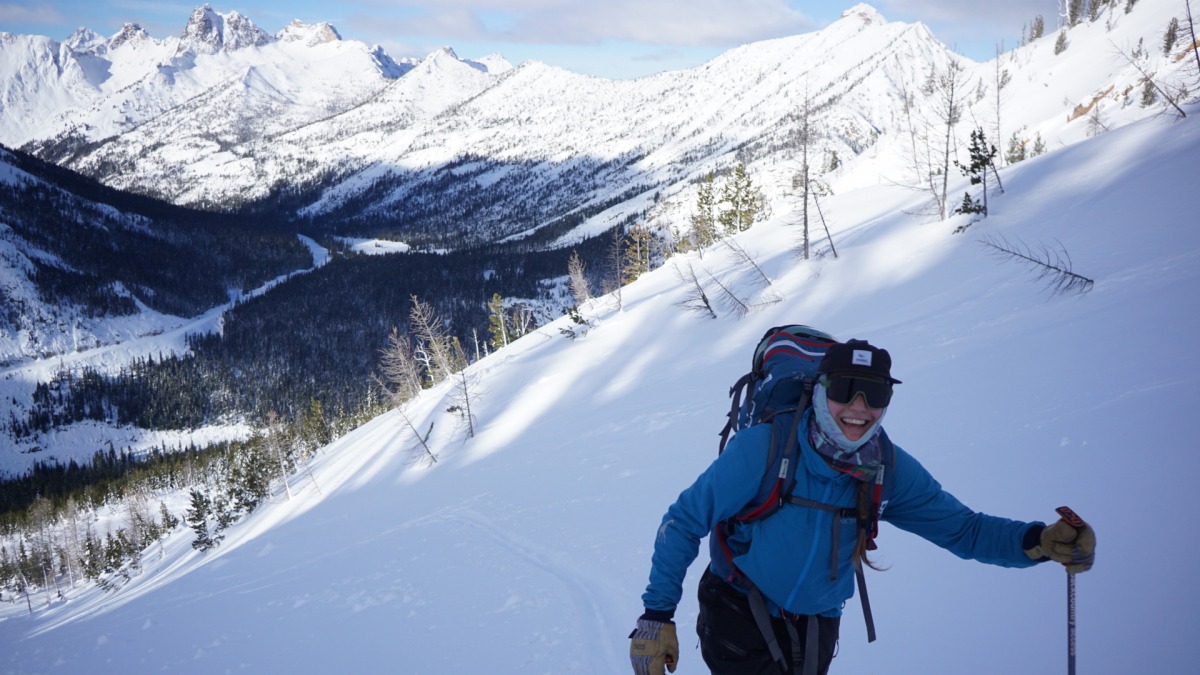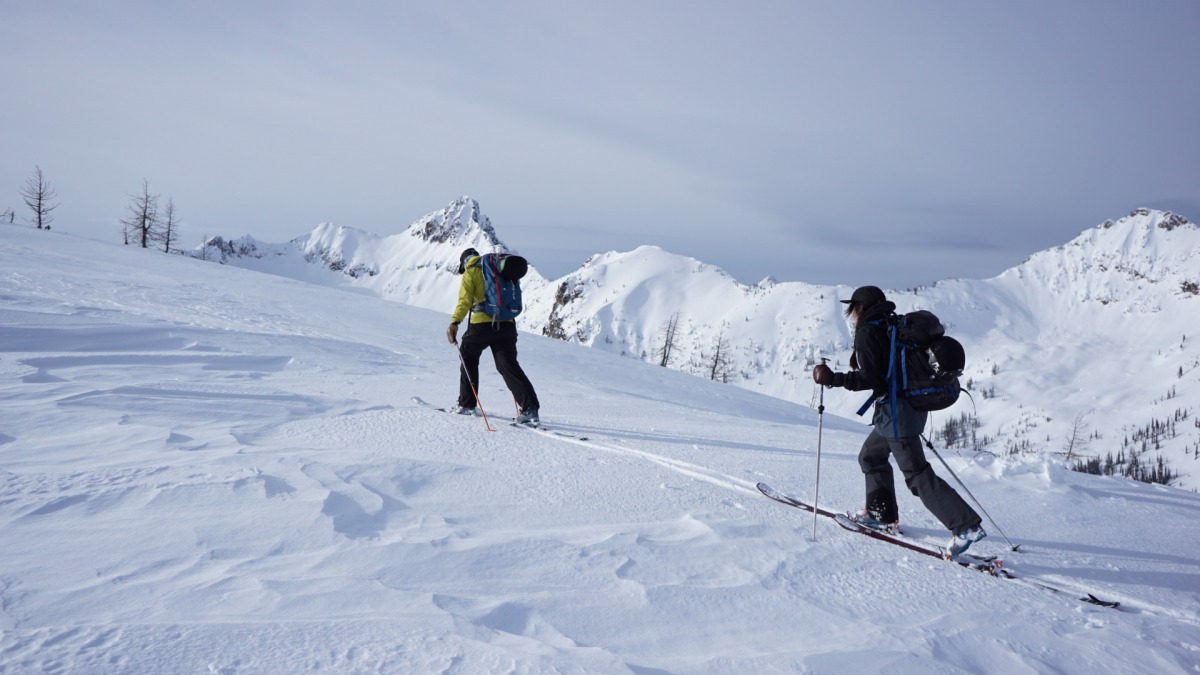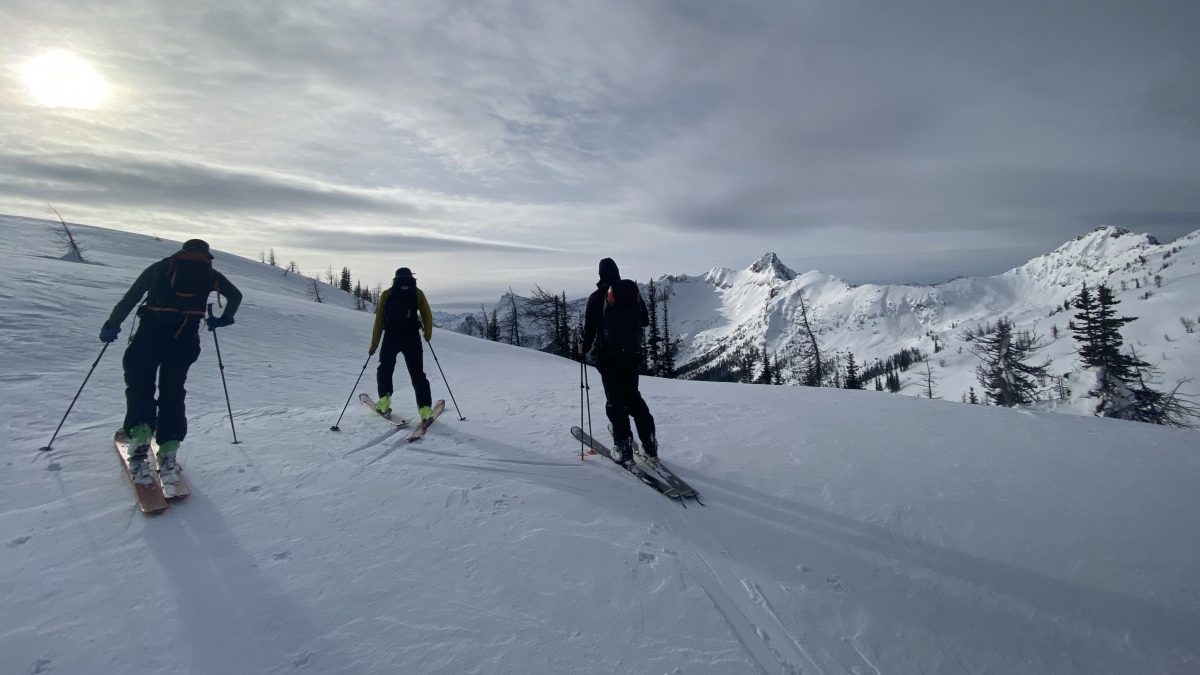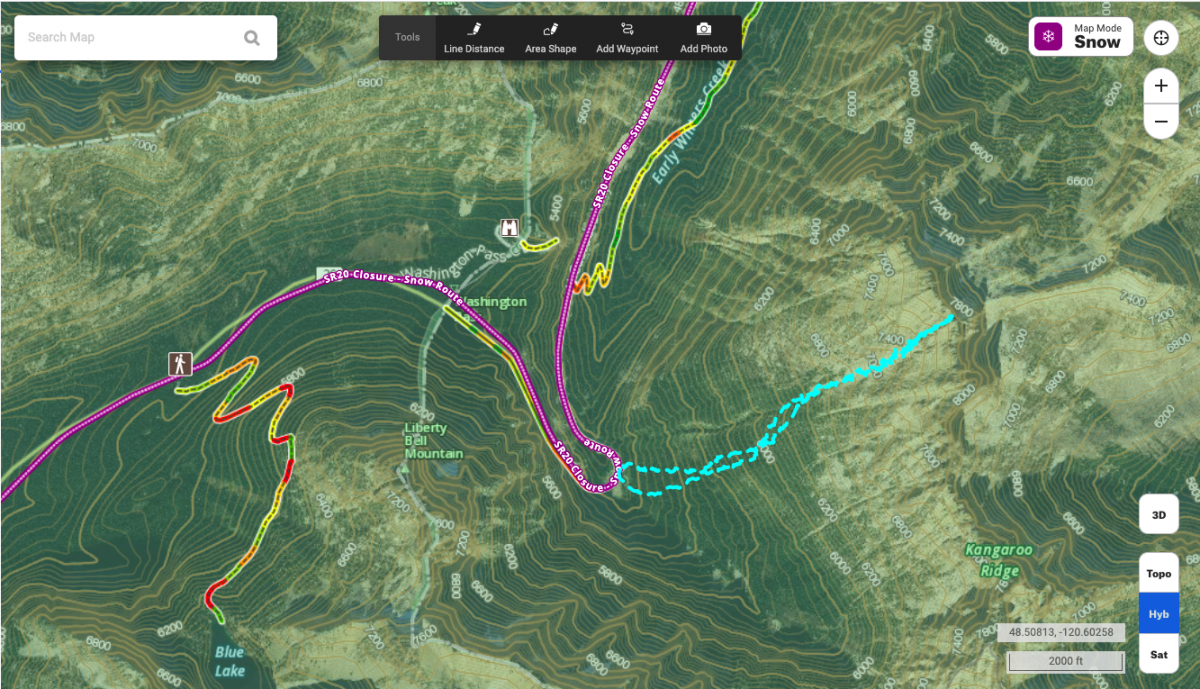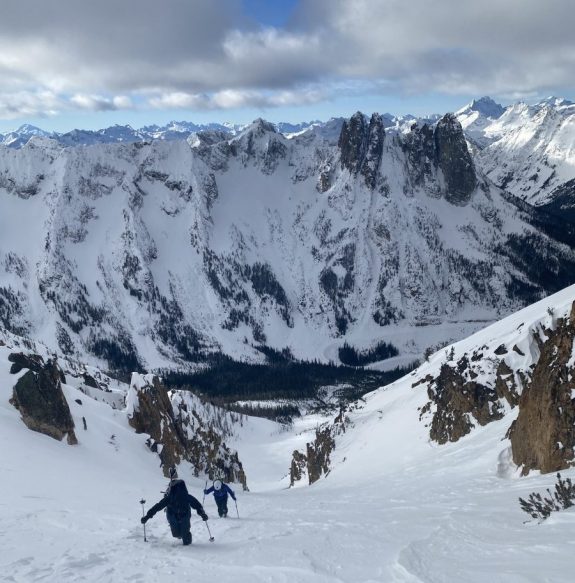Thanks to Onx Backcountry Maps for sponsoring our spring trip reports. Elevate your trip planning by saving 20% off your app subscription with the code WILDSNOW20.
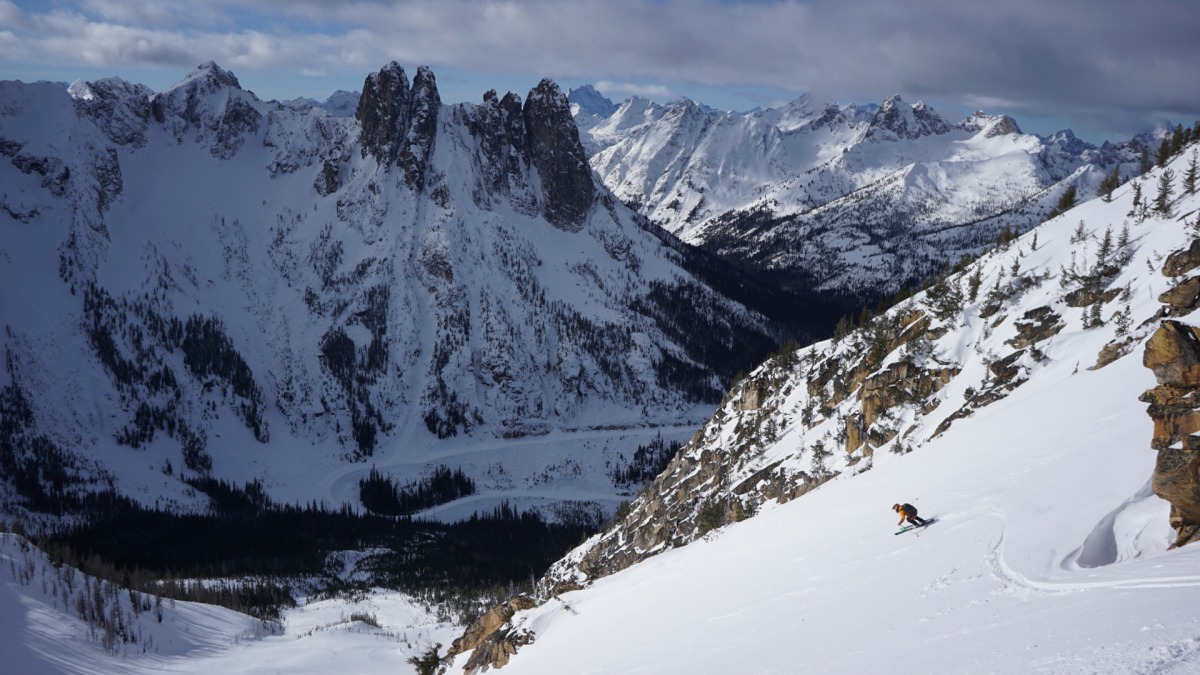
Louie opening it up as he exits the narrower portion of the couloir – can you feel the WA pass magic in this photo?
There is just something truly magical about Washington Pass in the winter. Maybe it’s the closed and snowed-in highway, or the silence that rests in the area during a snowmobile free pause. Maybe it’s the Cascades, maybe it’s all of it.
Washington Pass holds some of the most scenic and isolated mountains in all the Cascades, with peaks rising high right in front of you near the highway and many more visible in the distance. The landscape features variations of huge open bowls, tight couloirs, rock spires and lack of tight alder. The best metaphor would equate to a child in a candy store, except the child is my 30 year old self with skis on and the candy is some variation of good snow conditions mixed with an excess of exciting terrain options. A look into the WildSnow archives confirms that in winter, this part of the state offers some of the best pow skiing; in the spring, some of the best roadside corn snow; and in summer, excellent alpine granite climbing.
The pass is located at the highest point of highway 20, in the northeast area of Washington State. The highway usually closes for the winter season in late fall and reopens again in late spring, depending on the snow levels. The closure is in place between milepost 137, just east of Diablo Lake, and milepost 177 at Early Winters near the town of Mazama. WSDOT works hard to get the highway plowed and opened in the spring; this year the snow depth on the highway is over seven-feet deep. While the highway is closed in the winter, snowmobile travel is allowed, which attracts a lot of skiers to access the remote area.
Living just a bit east of Seattle, we don’t frequent Washington Pass all that often. The four hour drive, hauling snowmobiles, finding a cozy place to stay all make the trip a bit involved. In 2021, after various discussions related to properly managing travel/adventures during covid, our yearly visit to WA Pass happened on my birthday (January, MLK weekend). No better gift than mostly blue skies, thick breakable crust with a side of pow on northerly aspects and no wind for three out of the four days. I couldn’t ask for a better birthday present this year.
We are lucky enough that NWAC (our local avalanche center) has forecasters who frequent the region, providing us with valuable snowpack information for that region. The area is quite large, so ability to conduct personal assessment is definitely still required.
Over the years, the highway to WA Pass has been getting more visitors in all seasons. It was obvious that a lot of people had the same idea as us of making the trek; we ran into five different groups of people we knew who were gearing up to ski as we arrived. Various camper and van vehicles were scattered around us, with people slowly emerging outside with their morning coffee. Earlier in the week it had rained just about everywhere else in the state, except for WA Pass. However, even with lots of people at the parking lot, we hardly ran into anyone during our tours.
With no ability to bring both both our snowmobiles and our camper, I gifted myself a stay at the Freestone Inn near Mazama, just a quick 5 minute drive from the end of the closed highway. The room we rented featured a full kitchen, 2two bathrooms, and slept four comfortably. We split the room with our friends Kristen and Connor who have agreed to enter our so called covid bubble for the weekend. Our two other friends, Krystin and Peter, stayed in their camper at the end of the road. Since the Freestone Inn doesn’t allow trailers on their property, we left the trailer and our snowmobiles parked out of the way at the end of the highway.
The Freestone Inn has a variety of stand alone studio cabins that can be rented starting at $99 a day. However, those do get booked out in advance so it is harder to catch an opening last minute. We were lucky to snag a room that someone cancelled, even though it was a bit more pricey. There are cheaper accommodations in the town of Winthrop or Twisp, but a slightly longer drive to the trailhead is required.
With four snowmobiles and six people, we had lots of good doubling practice. Doubling on a snowmobile is not always fun, but a great skill to develop, so we made the best of it. Peter and Krystin have never been up in the winter, and sharing the WA Pass adventure with them was more important than the comfort of snowmobile travel. In all honesty, I didn’t find this holding us back, but some skill was definitely required. Snowmobiling conditions were superb, on a well-ridden track with many whoops. If there had been more new snow, it would have made for a lot more challenging doubling conditions. I definitely recommend the snowmobile to human ratio to be 1:1 if possible.
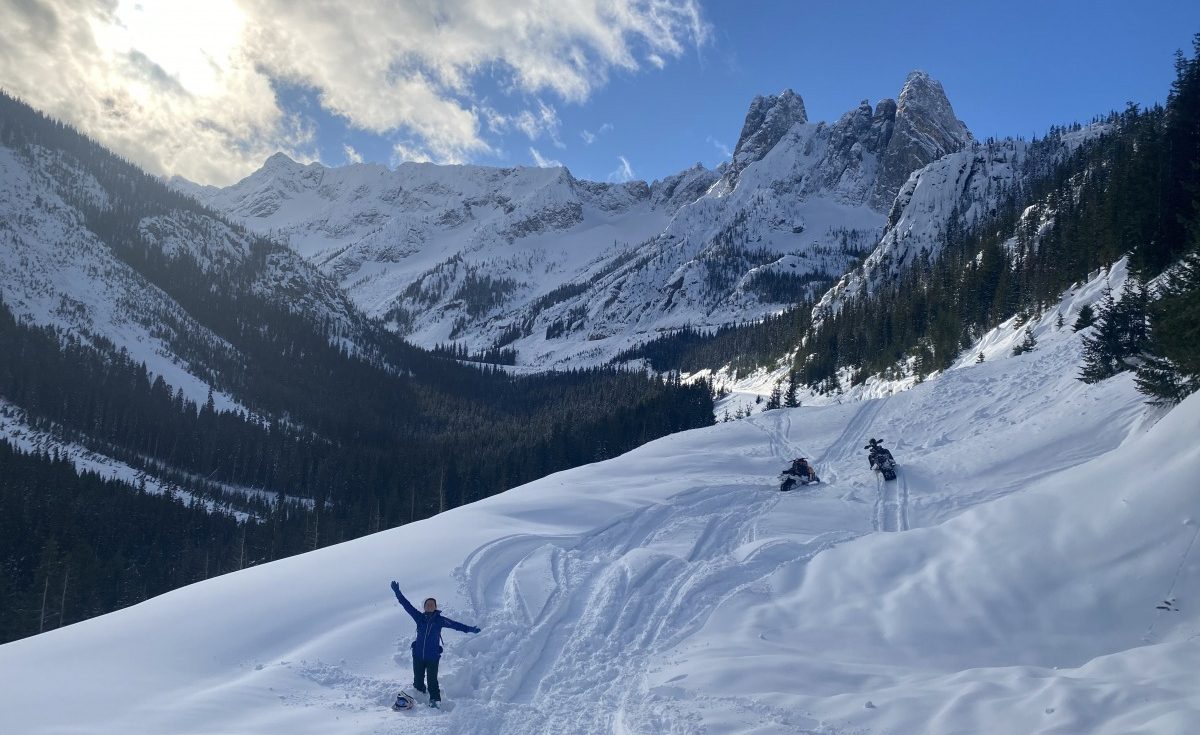
Some of the old avalanche debris visible on the road just past the snowmobiles, just a little below the top of Washington Pass. The spires visible and gorgeous, Kristen looking stoked to be able to finally get out in this area.
Washington pass skiing is accessed primarily by snowmobile. During seasons with lower snowfall, it could be possible to skin in to access skiing terrain but options are limited. The distance from where we started snowmobiling to the top of the pass was 15 miles and the route to Cutthroat pass was 11 miles. Getting to the top of the pass can be very challenging — once past the Cutthroat pass turn, the highway is quite exposed to avalanches. It’s common that this section of the road may be impassable. A few avalanches did run the week prior to our trip, but those had not deposited enough snow to block the road and stop us from continuing up. The moderate avalanche forecast and clear/mostly calm weather during the trip allowed us to feel comfortable traveling in that area, but that is definitely something to be aware of for each ski day.
We spent four days skiing and soaking in the beauty of the area. On the first day, we snowmobiled to the top of the pass (elevation of ~5400 feet) and went on a tour from Blue Lake trailhead. We found nothing but breakable crust, which had us wondering if this area didn’t actually escape the rain after all. On the second day we explored all aspects around Cutthroat pass. We only found good snow on the north-facing aspects but it was fun to do what basically ended up a circumnavigation of the terrain. We watched North Cascade Heli drops happening around us, as it was a beautiful clear day, and we schemed about other visible peaks that we wanted to climb. We had ambitious plans to ski a few couloir lines on the third day, but were stopped by changing conditions due to wind and had to settle for skiing some northerly aspects around the top of the pass. On the last day, my actual birthday, we skied Kangaroo Couloir — a quick skin and boot from just below the pass, visible from the highway. I have looked at this couloir each time I have driven on Highway 20, so it felt really cool to stand on top of the line, looking back down.
Getting back to the car, feeling exhausted physically but extremely refreshed mentally, we made our journey back home. Even though we weren’t gifted with dreamy powder conditions this time around (the thing about ski trips, right?), I was very content with time spent in the mountains. Shameless plug: a visit to the Twisp Bakery is an essential part of the journey. All of their goods are to die for and offer appropriate fuel pre as well as post trip. This time I walked out with six goodies and zero regrets.
WildSnow Girl, Julia Dubinina, is a weekend warrior chasing snow in winter and sun in summer. A lover of long tours and steep skin tracks, she explores the Pacific Northwest and beyond. When she is not out adventuring, she is working away at her corporate desk job for a software company to make her next adventure happen.

